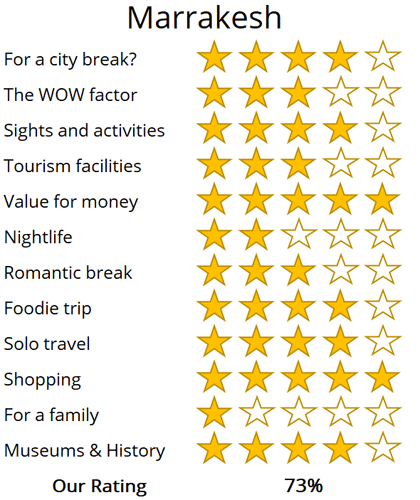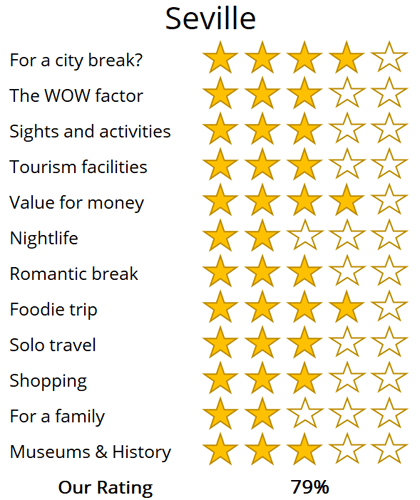WhereToGoForMyHoliday.com
The best destination comparison site!
WhereToGoForMyHoliday.com
The best destination comparison site!
Marrakesh or Seville, which is better for your holiday in 2024?
Seville and Marrakesh both offer unique and enticing experiences, but which one should you choose for your city break or holiday?
We understand your dilemma. There is an abundance of travel guides for both cities, but few actually comparing them, and advising you which is the better for your trip.
This article will provide our unbiased and independent views of Seville and Marrakesh, hopefully making your choice that little easier.
The article is structured into several sections, each of which can be directly accessed through the following links:
• Introduction to the cities
• Scores and ratings
• Which one should I, friends, or family visit?
• When to visit and weather
• Who is the city suited for?
• The perfect 48hours (with map)
• Tourism details (where to stay? airport details?)
Introduction to Marrakesh and Seville
Seville as a destination reflects that of the city’s famous dance, the flamenco; it is hot, passionate and instantly captivating. Seville boasts exceptional tourist attractions , and it’s rich cultural heritage will leave you longing for more.
Modern Seville is the interplay of its turbulent past, blending together Moorish roots and Christian influence in a city which wants to enjoy and embrace the present. Seville’s heritage is proudly displayed throughout the city, from the magnificent Alcázar palace, to the towering cathedral, mouth-watering tapas restaurants and impromptu flamenco dances.
Strangely, Seville typically lacks the appeal to the younger generation of tourists, but chance a trip and fall in love with the flare of southern Spain.

Marrakesh will steal your senses….
Mystical and magical, Marrakesh could have been plucked from One Thousand and One Nights.
A city of souks and madrassahs, it will enthrall with its spice markets, lantern bazaars, pottery hawkers, carpet stalls – the list goes on. All that resides in the throbbing medina area, anchored on Jemaa el-Fnaa square, where you'll dodge snake charmers, fortune tellers, monkey tamers, and dance troupes come the evening.
Around the medieval centre of town is a sprawling modern city. Neighborhoods there come in the form of stylish Gueliz, with its Parisian-influenced boulevards and palm-lined streets.
There's also the Jardin Majorelle, where the designer Yves Saint-Laurent has wrought the cacti plumes and the ponds into something truly special.

The skyline of the Marrakesh with the Atlas Mountains covered in snow in the distance

The Torre del Oro once guarded the Guadalquivir river and Seville
Seville vs Marrakesh: City Ratings
Summary
Where would I journey for a personal escape?
Marrakesh
Where would I send my parents for a memorable visit?
Seville
Where's the ideal destination for my adventurous 19-year-old cousin?
Marrakesh
Where should my food-obsessed friend indulge their culinary passions?
Seville
Note: The above comparisons are weather-independent and are based on travel during the most opportune times of the year. Details about the ideal travel seasons are elaborated upon later in this article.
In the sections that follow, you'll find a comprehensive comparison between these two fascinating cities. This includes recommendations on the duration of stay, the best times to visit, and tailored 48-hour itineraries for each city.
The final segment delves into practicalities for your travels, such as the best airport to fly into, the optimal districts for your accommodation, and insider tips, for when you come to explore the city.
We hope that you find all of this information useful, in planning your next exciting trip!
Destination details
How long to spend each city?
Two or three days is usually enough to get a good feel for the character and charms of Marrakesh.
In fact, lots of travellers say that any more than that is downright exhausting. That's because the touts and hawkers in the bazaars don't ever give up, and there's not much of a conception of personal space.
Still, 48 hours or so shouldn't be too overwhelming. And it will be plenty to check off the medina, the Majorelle Garden, stoic Koutoubia Mosque, and the lovely parks, all while having enough time to enjoy the enchanting riad hotels offered by this corner of the world.
Lots of travellers will be tempted to stay longer by the promise of the Atlas Mountains that loom on the horizon. If you can, a jaunt to those is definitely a good idea. It's a bus of a few hours up to the trekking hub of Imlil. From there, you can get a guide to navigate some gorgeous trails, and even climb the highest peak in North Africa (Mount Toubkal at 4,167 metres).
Seville calls for a more unhurried exploration to truly soak in its relaxed pace and tapas culture. Two days in Seville allow for a comprehensive sightseeing experience, though a single, brisk day could cover the essentials.
Be mindful of the extreme summer heat, necessitating an earlier start to your day and a slower pace.
For those looking to venture beyond, day trips to historic Cordoba, the coastal city of Cadiz, or the dramatic Pueblos Blancos are worthwhile, though the latter may require a rental car or guided tour due to limited public transport options.
Insight: While Granada is a captivating destination, it is best experienced as part of a longer itinerary, perhaps alongside Seville and Málaga, for a fulfilling week-long holiday.
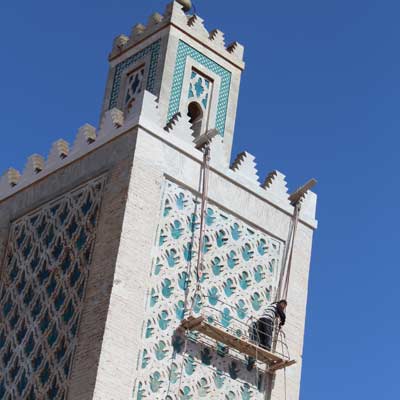
Cleaning the Kutubiyya Mosque tower, Marrakesh
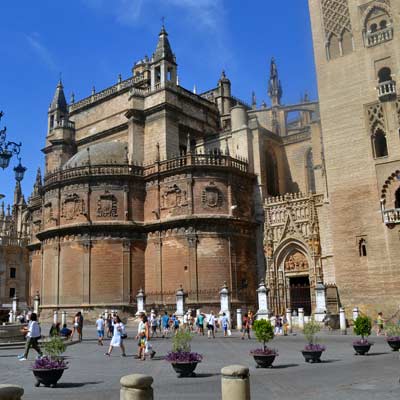
The Gothic Catedral de Sevilla
It's no secret that Morocco gets hot. In fact, the summertime here can see temperatures exceed 40 degrees on a regular basis. That's not good for sightseeing and walking around. In fact, it can be downright exhausting. What's more, the crowds spike in Marrakesh between July and August, as holidaymakers flock in, even despite the soaring mercury levels.
Much better options are spring, in April, and autumn, in October. They have average highs in the upper 20s, and hardly a drop of rainfall. It's probably wise to avoid Ramadan dates, however, because that can affect transport and hotel services. Marrakesh also offers winter sun. Drop in between November and March to find average warmth of 18 degrees and clear blue skies. Evenings can be cool then, so a jumper is advisable.
The best time of year to visit Seville is during the two festival periods of Semana Santa (held in the week before Easter) and the Feria de Abril (starting two weeks after Easter).
For a regular trip, late autumn and early spring are the best seasons, as during the long summer (June-September) the city is oppressively hot. Winter provides good value and fewer tourists but there is always the potential of rain.
Seville is a pleasure to visit, so long as you can either handle (or avoid) the extreme heat. This is a city for a slower paced trip, to enjoy time in the open-air cafes and to embrace the culture of Andalusia. This makes the city ideal for a break from a stressful lifestyle or hectic work schedule back at home.
The ambience typically appeals to a slightly older visitor, but to assume Seville is a mature destination would be completely wrong. There are exciting tourist attractions, a colourful nightlife and a social atmosphere. One of the appeals of Seville is that it is not a common city break and few of your friends will have been there.
Feeling adventurous? Then, yes – Marrakesh is for you! An amazing place of spice smells and pandemonius markets, it's nothing like the cities you find on mainland Europe. You'll be hassled at every corner.
You'll dodge donkeys and hurtling minibuses. You'll encounter strange snake charmers and magicians. But all that is part of the fun, and what makes this Moroccan jewel the perfect place to break away from the comfort zone.
There's also something of a luxurious edge to Marrakesh. If you're willing to fork out for a hotel, then you can bag some seriously plush places, whether it's an inner-city riad with flower-filled courtyards or an oasis resort with infinity pools overlooking the Atlas Mountains.

The Jamaa el Fna market square at sunset

The Plaza de España is always a highlight of Seville
Follow this fun-filled itinerary to make the most of your trip to Marrakesh. In just 48 hours, it packs in broiling tagines and stunning mosques, not to mention walks through the famous souks.
Day 1: Dive straight into the souks. Frantic and fun, these are the lifeblood of Marrakesh; ancient marketplaces where Berbers and spice traders once plied their trade. Things are now a little more tourist orientated. Head to D.El Maâden street and you'll find handcrafted leather bags and sandals.
Coming off that is the souk of the Babouches, where tanned slippers burst from every cobbler shop. You can then move to Souk Chouari to find whittled trinkets and statues in the carpenter's quarter. Still going north, you soon come to Souk des Teinturiers, where the pungent smells of tanning chemicals herald the leathermaker's market.
Double back and walk past Cafe Árabe to refresh with some mint tea and biscuits. Then it's into the heart of the medina, where the hubbub of Souk Semmarine unfolds with lantern shops, pastry vendors, and sparkling gold jewellery. Also be sure to breeze through the fragrant Souk Et Attarin, stacked with colourful soaps and all sorts of healing herbs.
Southwards brings you along Kennaria dabachi street, home to the veggie-friendly Corner Café and its falafel pitas (a great lunch). South again and you'll hit the Bahia Palace.
A whopping 160 rooms fronting vast courtyards and palm-topped gardens awaits there – a glimpse onto the grand old age of the viziers back in the 1800s. For dinner, return to the souks to find loads of spots selling aromatic tagines in traditional clay pots.
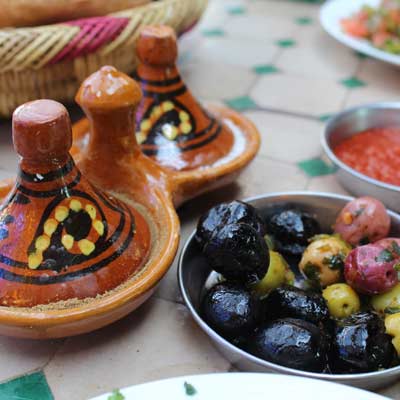
Expect delicious food while in Morocco
Day 2: Don't be tempted by the allure of the bazaars right away. The other – more modern – half of Marrakesh awaits on day two. Find that to the west and north of the medina, holding the secret Majorelle Garden. This is unquestionably one of the city's (and all of Morocco's) most enchanting attractions.
A pleasure park that has been landscaped and curated by, among others, the French fashion designer Yves Saint-Laurent, it hosts a vivid blue villa and ponds peppered with lily pads. Beyond is the district of Gueliz. That was built in the image of France, so expect wide boulevards and chic café-bakeries, along with classy clothes stores and bistros.
For lunch, the quiet Cyber Park is a great place for a picnic. It's got babbling fountains and benches in the shade of date palms, all framed by the snow-capped Atlas Mountains. It's also a short walk from there to Jemaa el-Fnaa – the great plaza in the middle of the city.
Arrive in the early evening and you'll see entertainers of all sorts. Curious dancers, mystics speaking in tongues, the infamous snake charmers – they all make an appearance. To the side is the wonderful Koutoubia mosque, which looks especially handsome during sunset.
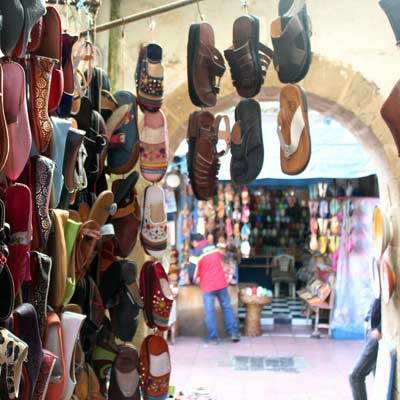
The colourful markets of Marrakesh

Majorelle Gardens
Below is an interactive map for 48 hours in Seville; day 1 is highlighted in green and day 2 in yellow, with optional sights in grey.
Start the day in the impressive Catedral de Sevilla, and climb to the top of La Giralda bell tower for a wonderful viewpoint. Surrounding the cathedral is the atmospheric Santa Cruz district, with its traditional houses and narrow cobblestone streets, which follow the old medieval layout of the city.
For the afternoon, visit the grand Plaza de España and the adjoining Parque de Maria Luisa. Towards the end of the day join a cruise along the Guadalquivir River. For dinner, head to the Triana district for an authentic Tapas meal. This district is also where flamenco dancing originated, and one of the bars may well have some impromptu dancing happening during the evening.

The gardens of the Real Alcázar palace
For the second day, start by visiting the Real Alcázar palace, the finest example of Mudéjar architecture which fuses Arabic and Christian designs. For the afternoon, head north of the historic centre and explore the popular shopping streets of Calle Sierpes. End the afternoon at the Setas De Sevilla, a massive wooden structure and great viewpoint.
In the evening, watch a flamenco performance at the La Carbonería.
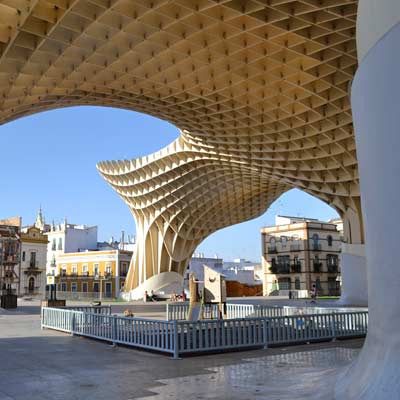
The Setas De Sevilla is the world’s largest wooden structure, but few know what it actually is or the point of it……
Seville airport (SVQ) is 10km northeast from the city centre, and is connected by a regular bus service (35min €4.00). Many of the low-cost airlines focus on the coastal cities of southern Spain instead of Seville, which means the cost of flights can be surprisingly high - plus there are fewer departures. This means that demand for flights can be very high in summer (when the city is best avoided).
This high level of tourism also means that hotels tend to be more expensive than much of Spain, and it’s likely you will spend much more than you anticipated! If you are lucky enough to visit during the two festivals, book your accommodation well in advance. Seville is compact and very easy to explore on foot.

The Maestranza bullring; bullfighting is an important tradition in Seville
Marrakesh
Marrakesh Menara Airport sits just to the west of the heart of the city. It's now a major arrival point for low-cost carriers coming out of Europe, but also has premium flag-carrying airlines and domestic services coming into its runways. The distance from terminal to souk is just three miles.
However, you'll need to push a hard bargain with the taxi drivers outside for even that short journey – they're renowned for their scams and inflated prices. A fair rate is around 40-50 MAD. There's also a bus. Look for the No 19 Airport Express costing 30 MAD with a free return included if you make the trip within a fortnight.
You'll certainly need to have your wits about you in Marrakesh. Unlike any European city, it's hectic and in-your-face. There's always someone trying to sell you something or hassle you into taking a tour.
A simple 'no' and a determined walk past them is usually enough to shake off the attention. Always haggle for taxis and goods but try to keep the bartering light-hearted and fair. It's also best not to walk through the Guéliz district after dark – it's known for being the riskier area.
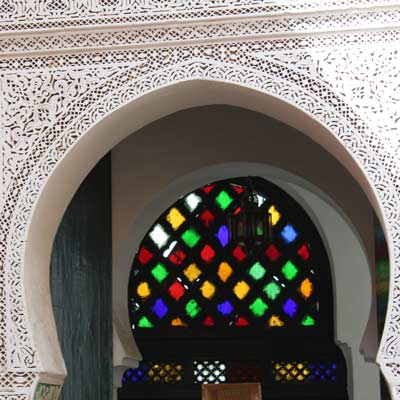
Beautiful Islamic art in Marrakesh
Hotel wise, there's really nothing like a classic Moroccan riad. In fact, we'd go as far as to say don't book anything else in Marrakesh. They're old, Berber mansions that are centred on a tiled courtyard that either has a babbling fountain or a small splash pool.
You can pay less and get a more traditional one, but the luxurious riads are an experience in themselves. They typically exist in the medina area and on its fringes.

oh we were stuck in the airport!

Copenhagen was a bit expensive...

All we did was drink beer in Brussels...

Muncih was crazy

And we got so burnt!

Remeber that night in Rome

oh we were stuck in the airport

So much fun kayaking

Berlin and that group from Austria!

There was such a view from that church

And we got so burnt!

Munich was eventful, wasn't it!

Such a view from that cathedral in Florence

Lisbon was such so much fun

Last summer was so much fun .... x

Remeber that night in Rome

Lisbon was such so much fun

Such a view from that cathedral in Florence

Munich was eventful, wasn't it!

And we got so burnt!

Remeber that night in Rome

All we did was drink beer in Brussels...

Berlin and that group from Austria!

Can't wait to go back to Dubrovnik

Remember that boat ride in Prague

Copenhagen was a bit expensive...
